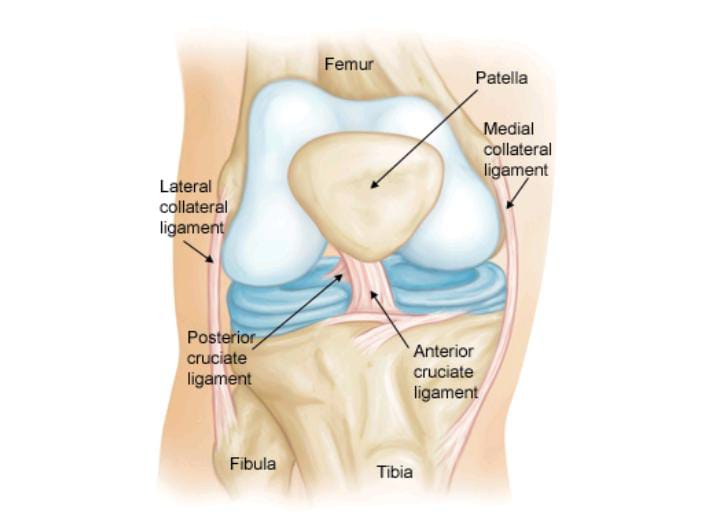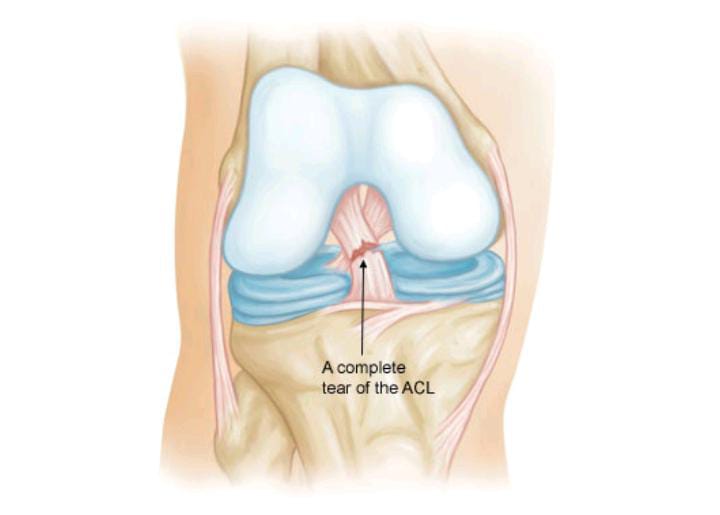ACL - Anterior Cruciate Ligament Injuries (Under Sports Injuries) ACL Repair & Reconstruction Surgery
The anterior cruciate ligament or ACL is one of the most important ligaments in the knee. When it is torn, reconstructive surgery is often necessary to stabilize the knee.
ACL Repair & Reconstruction Surgery

Anatomy of the Knee
The knee is responsible for providing us movement in our legs, allowing us to bend, walk, run and jump. The Anterior Cruciate Ligament (ACL) is the ligament responsible for limiting the forward motion of the tibia bone (shinbone), which is a good thing. It helps prevent the femur from sliding backward on the tibia and the tibia sliding forward on the femur. The ACL makes up one side of the crisscrossing ligaments that sits in the front of the leg and is centered between the femur and tibia bone.
The four ligaments of the knee provide stability and connect the knee to the femur and tibia that join it above and below:
- Anterior cruciate ligament (ACL) – Stabilizes the tibia bone and prevents it from sliding forward on the femur, and the femur from sliding backward.
- Posterior cruciate ligament (PCL) – prevents the femur from sliding forward onto the tibia.
- Medial collateral ligament (MCL) – Prevents the femur from sliding side to side.
- Lateral collateral ligament (LCL) – Provides the same function as the MCL.
What Does an ACL Injury Feel Like?
If you tear your ACL, you may experience one or more of the following :
- Sudden and severe pain
- A popping sound
- Swelling of the knee
- The inability to put weight on the knee
- Increased forward movement of the shinbone
Diagnosing an ACL Injury
The first step of an ACL repair will be seeing your doctor for testing. They will check your medical history and will give you a physical exam. An orthopedic surgeon will be able to diagnose your knee issue by asking about your knee, your symptoms, and any other past knee injuries. They will check your knees for stability, strength, swelling, and range of motion. Stability tests typically involve a Lachman test which compares the level of looseness in your knee and a pivot shift test. They may recommend an X-ray to look for any fractures or bone fragments in the knee or may order an MRI to identify an ACL tear. An MRI will give the doctor a clear picture of tearing in the ACL to give you an accurate diagnosis. If you have complete tearing of the ACL, and you’re experiencing instability, pain, and limited range of motion, your doctor will likely advise knee surgery for repair.
Diagnosing an ACL Injury
The first step of an ACL repair will be seeing your doctor for testing. They will check your medical history and will give you a physical exam. An orthopedic surgeon will be able to diagnose your knee issue by asking about your knee, your symptoms, and any other past knee injuries. They will check your knees for stability, strength, swelling, and range of motion. Stability tests typically involve a Lachman test which compares the level of looseness in your knee and a pivot shift test. They may recommend an X-ray to look for any fractures or bone fragments in the knee or may order an MRI to identify an ACL tear. An MRI will give the doctor a clear picture of tearing in the ACL to give you an accurate diagnosis. If you have complete tearing of the ACL, and you’re experiencing instability, pain, and limited range of motion, your doctor will likely advise knee surgery for repair.
Candidates for ACL Surgery
ACL surgery to repair a torn ACL is a good option if you have suffered a complete ACL tear, or have additional knee injuries. Damage to the meniscus cartilage is common with knee injuries, affecting about half of the ACL tears.
- You are an active adult who participates in low and high demand sports
- Your growth plates are closed (you are not a child)
- You have instability in the knee, knee pain, or a knee that gives out during normal activities
- Physical therapy and rehab have not worked to correct the ACL tear, pain, and instability
ACL Injury Repairs
When one or more of these ligaments is torn, the knee buckles or gives way. ACL tears most often happen during contact sports in which there is a lot of jumping, sudden stops, and changes in direction. Soccer, football, tennis, gymnastics, downhill skiing, and volleyball are sports where ACL tears are common. Landing from a jump incorrectly, pivoting with the foot firmly planted, suddenly slowing down and changing direction, and hits and collisions to the knee can also cause ACL tears. Women are more likely to suffer from ACL tears than men who participate in the same sports and activities. Studies show that women tend to land jumps in a way that puts stress on the knee, and have stronger muscles at the front of their thigh in the quadriceps than they do in the back of the thigh, the hamstrings. Strong hamstrings help prevent the forward motion of the tibia which can put stress on the ACL. Multiple tears in knee ligaments also lead to more repairs done on the affected knee. The treatment for ACL tears is reconstructive knee surgery. When an ACL is torn, surgery is needed to repair the torn ligament. In the past, invasive surgeries were the only option. Today, many ACL reconstructive surgeries can be done arthroscopically with just a few small incisions.
Do All ACL Tears Require Surgery?
Partial ACL tears may be mended and strengthened with rest and rehabilitation exercises. Physical therapy can often be successful for those with partial ACL tears and no instability issues, with complete tears and no instability issues who also don’t participate in high-demand sports, people who live sedentary lives, and children whose growth plates are still open. Full ACL tears will most likely require surgery to regain the person’s ability to stop and change direction easily and to perform normal tasks like walking without instability issues. Sewing a torn ACL back together is not highly effective, so ACL reconstruction is done with substitute grafting of tendons. ACL tears are treatable with arthroscopic surgery, a minimally invasive procedure that helps active individuals get back to regular activities and sports in as little as 6-9 months following the injury.
Arthroscopic Knee Surgery
Arthroscopic knee surgery is a minimally invasive procedure. Arthroscopy involves small incisions in which the surgeon inserts a camera and tiny surgical tools to perform the operation. Scarring is minimized, and surgical recovery times are considerably shorter. To top it all off, minimally invasive arthroscopic surgery is often just as effective as traditional open surgical procedures. In addition to ACL reconstruction, arthroscopy can be used to fix broken bones and damaged ligaments in other joints of the body.

What Does ACL Reconstruction Entail?
ACL reconstruction surgery involves a graft to replace the torn ligament. Autographs involving parts of the patient’s body are the most commonly used forms, which usually come from the tendon of the kneecap (patellar), from the hamstring, or from the quadriceps tendon. ACL reconstruction is typically done arthroscopically, which, as we described above, is minimally invasive and requires only a few small incisions into the knee. During the surgery, your surgeon will make several small cuts around the knee and clean out the inside of the knee using a sterile saline solution. From there, they will insert an arthroscope into one of the incisions and will be guided by the tiny camera on the end that projects images onto a screen. The surgeon will insert their tools into the other small incisions. They will drill small holes into the upper and lower leg bones where they come together at the knee. The holes form tunnels which the graft is anchored to. The surgeon will then make another small incision into the knee to take the replacement graft. The graft tissue is pulled through the tunnels and secured with screws or staples. The incisions are then closed and the knee is bandaged.
ACL Surgery Recovery
Immediately after the surgery, your knee will be swollen and you may have numbness around the incisions. You can use ice to reduce swelling. Your doctor may prescribe pain medication to ease discomfort. In the days following ACL surgery, you need to keep your incisions clean and dry and watch for signs of infection. ACL reconstruction recovery can take several months, and patients should progress gradually in their recoveries to avoid re-injuring their knees. The ACL reconstruction recovery timeline begins immediately after surgery, with the primary goal of reducing swelling and preventing discomfort. The next few weeks of recovery will focus on regaining motion in the knee joint. This involves extending and flexing the knee. The next goal is to regain strength. After about a month and a half to two months after surgery, patients can begin light jogging, bicycling, or swimming. Sports that involve side-to-side movements or pivoting, like basketball or football, should not be attempted at this stage of the recovery until a few months later. Patients can progress to that stage of recovery by performing exercises designed to simulate those activities. Athletes will be cleared to return to regular sporting activities only after being cleared by their orthopedic surgeon. When doing so, they might be advised to wear a knee brace. All told an ACL reconstructive surgery recovery could take eight months, a year, or two years depending on the severity of the tear
Collateral Ligaments
These are found on the sides of your knee. The medial collateral ligament is on the inside and the lateral collateral ligament is on the outside. They control the sideways motion of your knee and brace it against unusual movement.
Cruciate Ligaments
These are found inside your knee joint. They cross each other to form an "X" with the anterior cruciate ligament in front and the posterior cruciate ligament in back. The cruciate ligaments control the back and forth motion of your knee. The anterior cruciate ligament runs diagonally in the middle of the knee. It prevents the tibia from sliding out in front of the femur, as well as provides rotational stability to the knee.
Description
About half of all injuries to the anterior cruciate ligament occur along with damage to other structures in the knee, such as articular cartilage, meniscus, or other ligaments. Injured ligaments are considered "sprains" and are graded on a severity scale. Grade 1 Sprains. The ligament is mildly damaged in a Grade 1 Sprain. It has been slightly stretched, but is still able to help keep the knee joint stable. Grade 2 Sprains. A Grade 2 Sprain stretches the ligament to the point where it becomes loose. This is often referred to as a partial tear of the ligament. Grade 3 Sprains. This type of sprain is most commonly referred to as a complete tear of the ligament. The ligament has been split into two pieces, and the knee joint is unstable.
Partial tears of the anterior cruciate ligament are rare; most ACL injuries are complete or near complete tears.

Cause
The anterior cruciate ligament can be injured in several ways:
- Changing direction rapidly
- Stopping suddenly
- Slowing down while running
- Landing from a jump incorrectly
- Direct contact or collision, such as a football tackle
Several studies have shown that female athletes have a higher incidence of ACL injury than male athletes in certain sports. It has been proposed that this is due to differences in physical conditioning, muscular strength, and neuromuscular control. Other suggested causes include differences in pelvis and lower extremity (leg) alignment, increased looseness in ligaments, and the effects of Oestrogen on ligament properties.
Symptoms
When you injure your anterior cruciate ligament, you might hear a "popping" noise and you may feel your knee give out from under you. Other typical symptoms include:
- Pain with swelling. Within 24 hours, your knee will swell. If ignored, the swelling and pain may resolve on its own. However, if you attempt to return to sports, your knee will probably be unstable and you risk causing further damage to the cushioning cartilage (meniscus) of your knee.
- Loss of full range of motion
- Tenderness along the joint line
- Discomfort while walking

